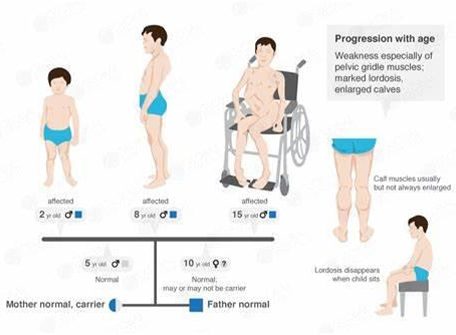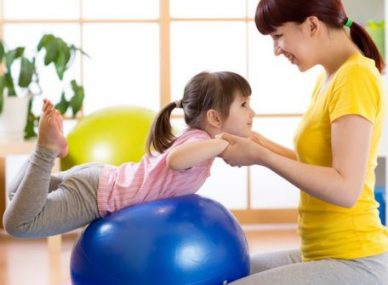MUSCULAR DYSTROPHY
Muscular dystrophy is a disorder of the musculoskeletal system that is characterized by progressive weakness and atrophy of varying severity of various muscle groups. This disorder has many genetic presentations giving rise to its different types and forms. There are nine clearly defined types of MD, each differing in age of onset, clinical symptomology, muscle groups impacted, and associated complications The combined prevalence is reported to be between 19.8 and 25.1 cases per 100,000 person-years.
There are nine clearly defined types of MD, each differing in age of onset, clinical symptomology, muscle groups impacted, and associated complications. Duchenne MD (DMD) and Becker MD (BMD) account for more than 80% of all cases.

Causes
Muscular dystrophy is primarily an X-linked genetic disorder which may be either in autosomal recessive or dominant form. Thus, the defective gene is carried by a female carrier.
Symptoms
The hallmark feature of the MDs is weakness of the skeletal muscles, which likely develops as a result of cellular death. The muscles involved—limb, axial, or facial—and the distribution of muscle weakness (proximal/distal) vary according to the type of MD.
Duchenne’s Muscular Dystrophy:
Duchenne muscular dystrophy (DMD) is the most common form of muscular dystrophy. Boys are most commonly affected by it . The condition leads to progressive deterioration of muscle fibers.Onset of weakness can become clinically apparent as soon as an infant begins to walk or as late as the second decade of life. Ultimately, muscle weakness progresses to loss of ambulation.

Few sites like the hips and the calves seem to develop greater muscle bulk when actually that is purely fatty tissue deposition. This is called pseudohypertrophy.

Clinically, the Gowers sign is indicative of Duchenne’s MD whereby when a child is asked to stand up from a crouched-on-floor position, he uses his hands in a manner as if trying to climb over oneself in an attempt to stand erect.

GOWERS SIGN
The child is having difficulty with walking, running, jumping and climbing stairs. Walking may look different with a ‘waddling’ type of walk.

When you pick the child up, you may feel as if he ‘slips through your hands’, due to looseness of the muscles around the shoulder
Cognitive impairment, often manifesting as lower IQ scores, mental retardation, attention-deficit/hyperactivity disorder, and autism, may also develop
Complications
- Muscle weakness can result in some joints becoming tight – this is called a ‘contracture.

- Curvature of the spine (scoliosis) can occur due to muscle weakness. Pediatric physical therapy consultants in Dubai say that usually this happens sometime after the child needs a wheelchair. The scoliosis can cause discomfort and is not helpful for posture and breathing.

- breathing muscles weaken, causing shallow breathing and a less effective cough mechanism. This can lead to chest infections, because mucus and germs (bacteria) are not cleared so easily from the chest.
TREATMENTS AVAILABLE
Speech Therapy
MD patients who experience weakness in the facial and throat muscles may benefit from speech and feeding therapy
Occupational Therapy
As physical abilities change, occupational therapy can help relearn these movements and abilities. Occupational therapy aims to improve functional abilities and activities of daily living
Role of Physiotherapy in Muscular Dystrophy
The main goal of pediatric physical therapy is to maintain the available function in their limbs and attain maximum possible improvement in the associated disabilities.
Passive movement: Passive movements are a technique that involves movement of limbs by the CP child physiotherapy, in all ranges, in a manner so as to maintain joint and muscle integrity.
Active assisted movements: The MD patient has limited muscle power. Therefore, with maximum effort, they can attain only a limited range by active contraction of their muscle. To maintain this power, maximum amount activity upto the fatigue threshold should be encouraged in these patients.
Stretching maneuvers: Often again due to immobility and poor power of muscles, the muscles shorten in length. The joints adapt a gravity assisted position and internal muscular forces cannot work against the external gravitational force. As a result of this joint contractures develop. To open up these joints and retain the normal muscle length, stretching is done on the joints.
Balance and Gait training: Muscular imbalances are so profound in MD that sitting and standing balance are greatly affected in the patients. So physical therapy for kids specialists use balance and gait training strategies to improve it.
Hydrotherapy: Hydrotherapy or aquatic exercises are an innate part of pediatric physical therapy rehabilitation protocol for MD. Activities are performed in water at a warmer temperature than the body. This helps in the following manner:
Buoyancy of water protects and braces the weak joints.
In water a person can feel very little of his/her own weight so this makes activities of partial weight bearing possible.
Adding floatation devices can assist the movements while adding high pressure water jets can help in performing mild resistance training in better muscle groups.
Warmer water helps in maintaining good thermo-stasis in the body and keeps the active muscle warm and hence at ease.






